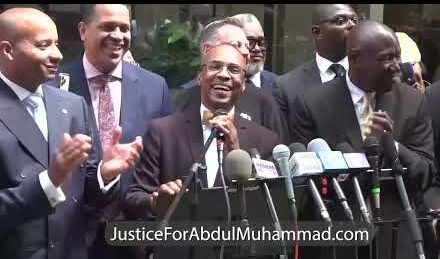Published by The Black Commentator, September 7, 2023
 We’ve been talking about the Black teacher shortage for years now using the hashtag #WeNeedBlackTeachers. Because there has been no serious comprehensive assessment or commitment to resolution, the crisis has deepened. The pandemic worsened the overall situation. Tensions inside and outside school districts abound. Lawsuits are flying. Teachers are fleeing. Schools in Black neighborhoods are being shut down. And where are Black children in this hostile mix? They are caught in the crossfire and are suffering profusely – psychologically and academically.
We’ve been talking about the Black teacher shortage for years now using the hashtag #WeNeedBlackTeachers. Because there has been no serious comprehensive assessment or commitment to resolution, the crisis has deepened. The pandemic worsened the overall situation. Tensions inside and outside school districts abound. Lawsuits are flying. Teachers are fleeing. Schools in Black neighborhoods are being shut down. And where are Black children in this hostile mix? They are caught in the crossfire and are suffering profusely – psychologically and academically.
Beyond the university requirements, teaching in public schools requires a high level of love for Black children along with a genuine commitment to Black liberation via the education front. Most Black teachers come into the field excited about making a difference in the lives of children. They still step up knowing that the pay is not competitive, and that the working conditions are challenging.
There is a view that the Black teacher shortage was triggered by the Brown v. Board decision that integrated schools by shutting down segregated schools and using Black students to de-segregate all-white schools. Dr. Leslie T. Fenwick estimates that 100,000 Black teachers and principals were forced out of southern public school districts in her book, “Jim Crow’s Pink Slip: The Untold Story of Black Principal and Teacher Leadership.” She believes it was an educational catastrophe from which we have never recovered.
There are a few recruitment programs and fellowships for that are tackling the issue of shortage like the Black Male Educators for Social Justice and the Black Educator Initiative. The American Federation of Teachers runs a program in a Newark high school. Recruitment isn’t the only obstacle; retention is a huge hurdle.
So what happens when Black teachers are successfully recruited and certified? In several research surveys, Black educators report work environments that are not welcoming, respectful, or culturally affirming for these Black professionals. This is on top of the issues that engulf many urban school districts such as violence, student learning disabilities, poverty and fractured family structures.
If Black teachers are struggling to get through the day to fulfill their personal and professional missions, what’s happening with Black principals?
These folks have jumped through many credentialing hoops, attained multiple degrees (and the debt that goes with them) and dealt with bureaucratic anti-Black systems of oppression. National statistics put Black teachers at 7 percent of the teaching profession, but the number of Black principals plummets dramatically to about 2 percent.
Two scenarios which have crossed my radar could give us insights into the world of Black principals. Kacy Shahid was the high school principal of St. Louis’ first school shooting. Abdul Muhammad is one of Chicago’s Black principals targeted for unjustified removal.
The joy for Dr. Shahid of being placed at Central Visual and Performing Arts High School as principal was that it was her alma mater. In spite of the usual challenges of a principal, she loved it for eight years – until the unthinkable happened. Last fall, a CVPA graduate thrust the school into the national spotlight when he entered the school heavily armed and took the life of a beloved teacher and popular student. The shooter was killed by police, leaving behind a note of his troubled and lonely life.
What keeps the spotlight on the St. Louis Public School District is that this is the nation’s first public school shooting by a Black gunman. Months later, I can tell you first-hand that neither the district nor the city have come to grips with the tragedy and its reverberating trauma in order for meaningful healing to happen for the broader community.
After the tragedy, Dr. Shahid spent weeks on her own self-care, admitting publicly that “the weeks/months following the event were overwhelming.” She spent time deepening her understanding of what it takes for a human being to truly heal. This past summer, Shahid formally resigned from the St. Louis district. This fall she will join the leadership team of another school district.
Brother Muhammad did not have to survive a traumatic school shooting, but he certainly has endured brutal assaults on his reputation and livelihood from Chicago Public School officials and their lackeys. The coordinated attack seemed to have come when a school official wanted her friend to be the principal at Lindblom School. The friend didn’t make the cut; Muhammad’s exemplary resume made him the top choice coming out of the interview process.
The only way for CPS to tear down a 25-year decorated, veteran teacher and administrator is to fabricate lies to justify its actions. As Muhammad fought for his position, students, parents and the broader community came to his defense. They set up a website to set the record straight and to give updates on the case. As the investigation into his case deepened, it was discovered that a pattern was emerging of ousting Black administrators. The injustice caught the ear of civil rights attorney, Ben Crump, who is now representing several of the Black principals.
While the alarm bell is ringing about Black educator shortages, while the research shows that all demographics of student bodies benefit from diverse teaching staffs, Black teachers and principals are catching unnecessary hell. The more they are seen as advocates for their students, parents and communities, the redder the bullseye on their backs becomes. Valuable time, energy and monies are diverted from classroom instruction and student engagement when educators are forced to engage in petty in-fighting and bureaucratic dysfunction.
Teacher shortage is not just a local problem or a Black issue. It has national implications and must be put in its proper context. Under-resourced and under-staffed schools equal student under-achievement and school failures. Failures have a direct and long-term impact on our economy, our healthcare system, our social safety nets and the basic right to thrive.
Both the right to a quality education and the right to work in a safe environment are human rights. Perhaps the violation of human rights is a strategic segue to start discussing solutions to this chronic problem and placing it in an arena of international importance.



